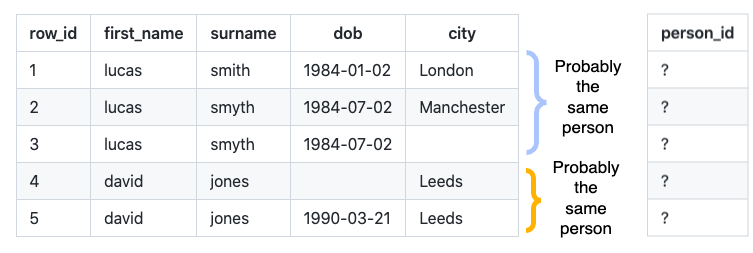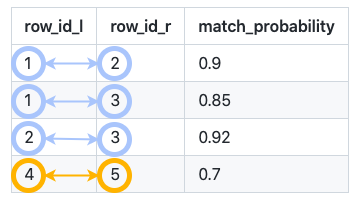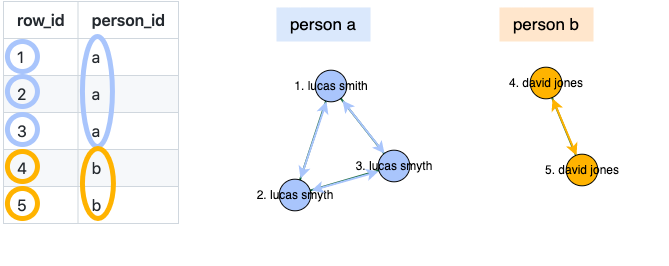Fast, accurate and scalable probabilistic data linkage
Splink is a Python package for probabilistic record linkage (entity resolution) that allows you to deduplicate and link records from datasets that lack unique identifiers.
Key Features
Splink's linkage algorithm is based on Fellegi-Sunter's model of record linkage, with various customizations to improve accuracy.
What does Splink do?
Consider the following records that lack a unique person identifier:
Splink predicts which rows link together:
and clusters these links to produce an estimated person ID:
What data does Splink work best with?
Before using Splink, input data should be standardized, with consistent column names and formatting (e.g., lowercased, punctuation cleaned up, etc.).
Splink performs best with input data containing multiple columns that are not highly correlated. For instance, if the entity type is persons, you may have columns for full name, date of birth, and city. If the entity type is companies, you could have columns for name, turnover, sector, and telephone number.
High correlation occurs when the value of a column is highly constrained (predictable) from the value of another column. For example, a 'city' field is almost perfectly correlated with 'postcode'. Gender is highly correlated with 'first name'. Correlation is particularly problematic if all of your input columns are highly correlated.
Splink is not designed for linking a single column containing a 'bag of words'. For example, a table with a single 'company name' column, and no other details.
Documentation
The homepage for the Splink documentation can be found here. Interactive demos can be found here, or by clicking the following Binder link:
The specification of the Fellegi Sunter statistical model behind splink is similar as that used in the R fastLink package. Accompanying the fastLink package is an academic paper that describes this model. The Splink documentation site and a series of interactive articles also explores the theory behind Splink.
The Office for National Statistics have written a case study about using Splink to link 2021 Census data to itself.
Installation
Splink supports python 3.7+. To obtain the latest released version of splink you can install from PyPI using pip:
pip install splinkor, if you prefer, you can instead install splink using conda:
conda install -c conda-forge splinkShould you require a more bare-bones version of Splink without DuckDB, please see the following area of the docs:
Quickstart
The following code demonstrates how to estimate the parameters of a deduplication model, use it to identify duplicate records, and then use clustering to generate an estimated unique person ID.
For more detailed tutorial, please see here.
from splink.duckdb.linker import DuckDBLinker
import splink.duckdb.comparison_library as cl
import splink.duckdb.comparison_template_library as ctl
import splink.duckdb.blocking_rule_library as brl
from splink.datasets import splink_datasets
df = splink_datasets.fake_1000
settings = {
"link_type": "dedupe_only",
"blocking_rules_to_generate_predictions": [
brl.exact_match_rule("first_name"),
brl.exact_match_rule("surname"),
],
"comparisons": [
ctl.name_comparison("first_name"),
ctl.name_comparison("surname"),
ctl.date_comparison("dob", cast_strings_to_date=True),
cl.exact_match("city", term_frequency_adjustments=True),
ctl.email_comparison("email"),
],
}
linker = DuckDBLinker(df, settings)
linker.estimate_u_using_random_sampling(max_pairs=1e6)
blocking_rule_for_training = brl.and_(
brl.exact_match_rule("first_name"),
brl.exact_match_rule("surname")
)
linker.estimate_parameters_using_expectation_maximisation(blocking_rule_for_training)
blocking_rule_for_training = brl.exact_match_rule("dob")
linker.estimate_parameters_using_expectation_maximisation(blocking_rule_for_training)
pairwise_predictions = linker.predict()
clusters = linker.cluster_pairwise_predictions_at_threshold(pairwise_predictions, 0.95)
clusters.as_pandas_dataframe(limit=5)Videos
Support
To find the best place to ask a question, report a bug or get general advice, please refer to our Contributing Guide.
Awards
Citation
If you use Splink in your research, we'd be grateful for a citation as follows:
@article{Linacre_Lindsay_Manassis_Slade_Hepworth_2022,
title = {Splink: Free software for probabilistic record linkage at scale.},
author = {Linacre, Robin and Lindsay, Sam and Manassis, Theodore and Slade, Zoe and Hepworth, Tom and Kennedy, Ross and Bond, Andrew},
year = 2022,
month = {Aug.},
journal = {International Journal of Population Data Science},
volume = 7,
number = 3,
doi = {10.23889/ijpds.v7i3.1794},
url = {https://ijpds.org/article/view/1794},
}Acknowledgements
We are very grateful to ADR UK (Administrative Data Research UK) for providing the initial funding for this work as part of the Data First project.
We are extremely grateful to professors Katie Harron, James Doidge and Peter Christen for their expert advice and guidance in the development of Splink. We are also very grateful to colleagues at the UK's Office for National Statistics for their expert advice and peer review of this work. Any errors remain our own.





